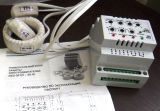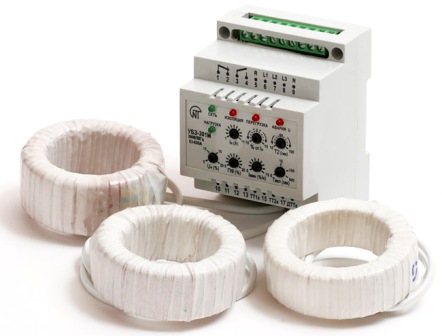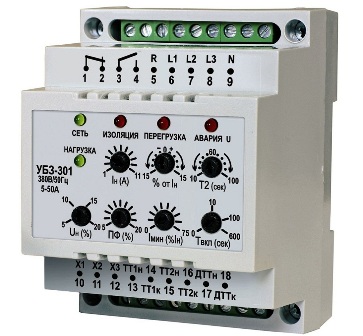Universal motor protection devices
 For reliable protection of electric motors, mainly asynchronous, with a capacity of units to hundreds of kilowatts, universal protection devices (UBZ) are used... They are digital microprocessor devices with a high degree of precision. Such devices have a wide range of options for configuring protection parameters, while the key function of the device is continuous monitoring of network voltage parameters, effective values of line and phase currents of three-phase equipment.
For reliable protection of electric motors, mainly asynchronous, with a capacity of units to hundreds of kilowatts, universal protection devices (UBZ) are used... They are digital microprocessor devices with a high degree of precision. Such devices have a wide range of options for configuring protection parameters, while the key function of the device is continuous monitoring of network voltage parameters, effective values of line and phase currents of three-phase equipment.
A controlled voltage is used to power the protection device and three current sensors included in the kit are used to control the current. Two sensors are for monitoring phase / line currents, phase power wires are passed through them, and the third is a differential sensor, three power wires are passed through it at the same time, it has an increased size.

The monitoring of network voltage and phase currents is carried out separately, but at the same time, which allows you to determine the specific type of emergency, in case of occurrence, and disconnect the protected equipment from the electrical network. If an emergency situation occurs, after restoring the acceptable values of the voltage parameters, the protection unit will automatically reactivate the load. If the cause of the emergency operation is internal damage to the engine, then an automatic restart lockout will occur.

In this way, the effective protection of the equipment is carried out in the following cases:
1) Bad mains voltage:
-
Unacceptable surges occurred;
-
A phase loss has occurred;
-
There is a fusion of phases;
-
Phase sequence is broken;
-
Fixed voltage phase unbalance.
2) Mechanical overload — symmetrical overload phase / line currents with a certain time delay.
3) Engine failure:
-
An asymmetric overload in phase / line currents has occurred; protection against phase current imbalance is triggered while automatic reclosing is blocked;
-
Asymmetric currents are recorded without overload, this may be due to a violation of the internal insulation of the motor (or the power cable);
-
In case of an unacceptably low level of insulation on the casing, the start will be blocked; the insulation check is performed automatically before switching on;
-
If the stator winding is shorted to ground, the leakage current protection will operate and the device will trip the contactor.
4) Protection suitable for pumps: in case of loss of torque on the motor shaft, that is, with unacceptably low starting or operating current, the protection will operate.
Potentiometers on the protection block panel allow you to simply and accurately set the value of the rated operating current of the electric motor, and not only the standard value from the scale, but also the permissible long-term overload can be set. The overload trip takes into account the set time delay.
In addition, according to the parameters of the current time, the protection device solves the differential equation of the heat balance and is able to fix the thermal overload by taking into account the previous state of the electric motor. It is possible to limit the number of thermal overloads per unit of time.
Operating thresholds for minimum and maximum voltage, unbalance of phase currents and network voltages, automatic reclosing time — all this is easily adjusted manually using potentiometers.
There is also an LED indication that signals the presence of mains voltage, the set current range, the load on and the type of alarm. The indicators may flash or be on continuously in a given situation.
Each such motor protection device is accompanied by comprehensive technical documentation, which describes in detail both the functions and parameters of the device, as well as its external interface and connection diagram with the load circuit, as well as a convenient way of setting and lighting modes of indicators.
